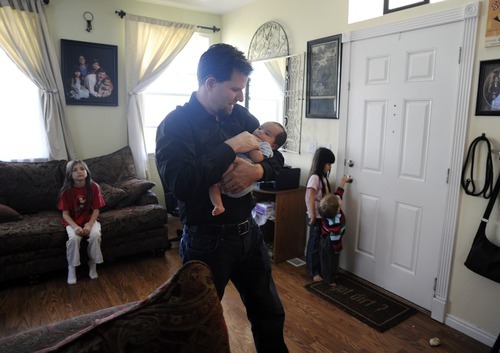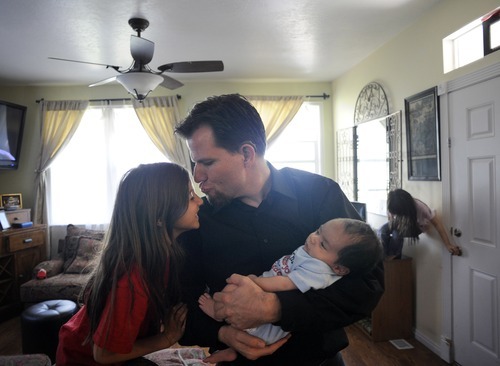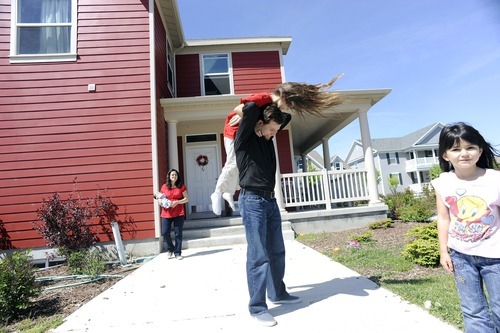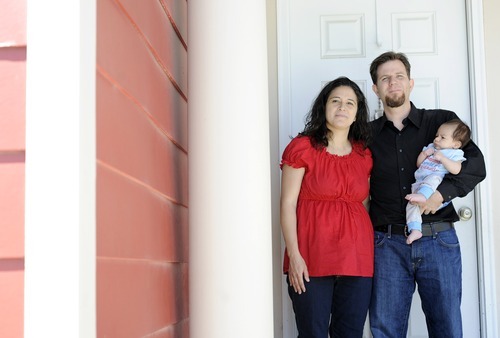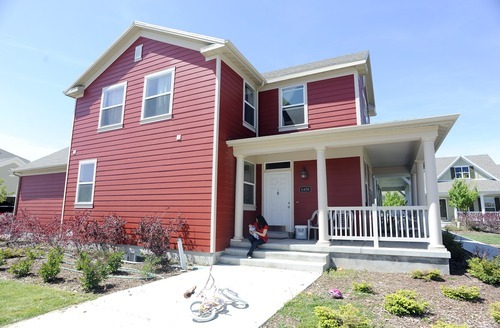This is an archived article that was published on sltrib.com in 2011, and information in the article may be outdated. It is provided only for personal research purposes and may not be reprinted.
South Jordan • Adam Schafer is absorbed with worry about losing his South Jordan home as he watches son Tommy push a talking Tonka truck across the living-room floor.
"Hold on, little buddy," the plastic toy chirps as the 2-year-old smiles. "Help is on the way."
But beyond unemployment checks, little help has come during the past year to the Schafers, one of more than 20,000 Utah families confronted by a foreclosure monster that is now snaking deeper into west-side suburbs along the Wasatch Front and smaller towns throughout the state.
Laid off a year ago from his information-technology job installing videophones for the hearing impaired, the 33-year-old father of four has landed just two interviews in applying for hundreds of jobs, a search for work sometimes complicated by his own deafness.
Maddening attempts to modify his home loan with Chase bank failed "after a paperwork hell," Schafer says. With at least $30,000 in medical debts and jobless benefits all but exhausted, he and his wife, Lisa, fret daily about the bank seizing their two-story house in Daybreak and forcing them out.
Beyond the financial devastation, foreclosure would mean being uprooted from a community they love, yanking children out of school and either moving in with relatives or leaving the state.
"We are absolutely on tenterhooks," Adam Schafer says, "waiting to see what happens."
For every house lost to foreclosure since the crisis began several years ago, another three or more could soon land in similar circumstances within the year, suggests a data analysis by The Salt Lake Tribune. A national report by mortgage bankers indicates one in 10 Utahns is either struggling to make house payments or is already losing the property.
Painful impacts swell outward from each of the distressed homes and foreclosure signs that now dot the landscape. The social, political and economic fallout is likely to be felt for years.
"It really is about all of us. We're all affected,'' says Layton Mayor Steve Curtis, who, last year, faced a wrongful foreclosure of his own. "It's your neighbor. It's your co-worker. It's someone in your church. It's your mayor."
—
Effect felt far and wide • Utah ranks fourth worst in the nation for foreclosure rates — one of every 322 housing units. Only Nevada, Arizona and California are worse. But a house-by-house mapping analysis by The Tribune of nearly 77,200 records provided by foreclosure-listing company RealtyTrac paints an even more complex and troubling picture.
Staggering in their statewide breadth, foreclosure patterns have intensified along the Wasatch Front's west side, especially in the housing-boom suburbs of Salt Lake, Davis, Weber and Utah counties. And in an indication of the construction bubble lending practices that precipitated the collapse, foreclosure clusters tend to be denser in housing developments completed just before the downturn.
The early stages of Utah's foreclosure disaster hit homeowners with ill-conceived and exotic adjustable-rate mortgages as plunging home prices prevented them from refinancing. While that first wave slammed residents at many income levels, a second, recession-driven tide followed, swallowing moderate-income Utahns with blue-collar jobs.
The paper's analysis indicates middle- and working-class neighborhoods in the state's four most populous counties are bearing a heavy foreclosure burden. Many of these areas have especially high levels of borrowers who were recently notified that they are at least 90 days behind on their mortgages.
Experts are now seeing a third wave of foreclosures from "strategic defaulters," weary homeowners who simply walk away from their underwater mortgages.
At the same time, foreclosures are spreading outward from Utah's metropolitan centers, with rising numbers of distressed homeowners and notices of trustee sales evident in Box Elder, Summit, Iron, Cache, Wasatch, Duchesne and Uintah counties.
This increasingly small-town trend of foreclosures is spurring new problems with the widespread stigma that deters troubled homeowners from seeking financial counseling.
"They won't come in for help in that they don't want to risk seeing their neighbor," says Kristin Johnson, a foreclosure-prevention counselor in northern Utah. "Places that are a little bit bigger, we don't have that so much."
Foreclosures had surfaced in 19 Utah cities in July 2008 but had reached 117 cities and towns across the state by December 2010.
The foreclosure expansion has widened the human toll, with estimates that it has now affected hundreds of thousands of Utah children.
"These kids are watching their parents being afraid and that fear of loss and instability,'' says Marco Fields, executive director of for-profitTEEMS Utah, which seeks to stop preventable foreclosures. "When you talk about the impact on neighborhoods, on schools, on churches, this is fraying our social network."
—
There goes the neighborhood • Analysis also suggests that foreclosures have thrust a glut of properties onto Utah's housing markets, with nearly 20,000 homes since July 2008 listed as "real-estate owned'' (REO) after delinquent owners were evicted and their homes failed to sell.
Overwhelmed banks and management companies often let maintenance on these properties languish, further depressing home prices and devaluing property values for neighboring homeowners.
Michael Thornell, a 72-year-old retired civil servant in South Salt Lake, is praying that property values in his area will rebound now that a new family has moved in next door.
For 18 months, Thornell watched helplessly as a neighboring home was stripped of its fixtures and left empty, dandelions growing 2 feet high.
"It brings the neighborhood down, makes it look trashy," Thornell says. "It looks better now than it has in four years."
According to an estimate by the U.S. Department of Housing and Urban Development, living next to a foreclosed property can knock as much as $7,000 off a homeowner's property value. In neighborhoods with many foreclosed properties, "you multiply that dramatically," HUD Secretary Shaun Donovan recently told The Tribune. "You get impacts that drive the whole market in the wrong direction."
Foreclosures and inefficiencies in programs to help homeowners modify their loans are sowing discontent with banks and lending institutions. The perception that banks have a profit incentive to foreclose appears to be a common complaint by homeowners.
"The word 'bank' has become this four-letter word, and it's become totally unfair,'' says Howard Headlee, president and CEO of the Utah Bankers Association. "In spite of all the conspiracies out there, nobody wins in a foreclosure."
—
More trouble on horizon • There are signs the hardship on Utah homeowners in the early stages of foreclosure will soon worsen.
Two years ago, Utah steered nearly $1.8 million in federal stimulus money to strengthening the state's network of nonprofit foreclosure counselors. That funding is scheduled to end next month, slashing the number of debt counselors by half.
According to the nonprofit Utah Housing Coalition, which promotes access to affordable housing, this network has saved at least 1,064 homes from foreclosure since August 2009. It has also guided homeowners away from scams that demand upfront payments for mortgage assistance but fail to deliver.
Counselors offer a lifeline to homeowners bogged down in the messy process known as loan modification. But with money for foreclosure counseling set to run out, advocates fear what will happen next.
"It is a real concern because, obviously, the problem has not gone away,'' says Marilyn Albertson, a member of the state-backed Utah Foreclosure Prevention Task Force. "Many of these people will have to turn to for-fee agencies when they don't have any money.''
The U.S. Treasury has set aside about $30 billion for incentives to mortgage lenders and homeowners to promote loan modification as well as other foreclosure alternatives, but some say the program has failed to make a meaningful difference.
"Modification, by and large, has not worked," says Julia Borst, presidentof the Utah Mortgage Lenders Association. "A lot of people still go into foreclosure."
In Saratoga Springs, Curtis Page, a 50-year-old father of four children, three of them teens, is on the edge of eviction and numb from frustration with his bank.
When the recession struck and his wife's online business fizzled, Page negotiated a lower mortgage payment with his lender. Six months into the program, the bank called to say it had lost the papers. It has been a nightmare ever since.
Page has argued so long and so hard about a house payment he says he never missed that, whenever a loan agent now calls, the ex-high school football coach simply hands the phone to his wife.
"Those people that are working there, they're getting paid minimum wage, $6 to $7 an hour. They don't know crap,'' he says. "It went on and on and on and on. I can't deal with this anymore.''
Loan-servicing companies — hired by banks to manage contacts with borrowers — continue to be swamped by a crushing and unexpected load of foreclosure filings and requests from homeowners seeking to lower their payments.
On the other side, Utah homeowners complain about lost papers, interminable delays, frequent mistakes in case handling and zero guarantees that loan modifications will halt, or even slow, a foreclosure.
Loan servicers "are numb about this,'' says Raul Campos, a real-estate investor and adviser to foreclosure-threatened homeowners. "We used to be able to pull their heartstrings, but now, they could not care less."
tsemerad@sltrib.com Twitter: @Tony_Semerad
—
—
How to find foreclosure help
Free assistance
Housing counseling agencies in the state approved by the U.S. Department of Housing and Urban Development.
> bit.ly/cp7Uhd
Utah Foreclosure Prevention Task Force
Although a federal grant is about to run out, this Utah Housing Coalition-run site will steer distressed homeowners to free services from trained and industry-certified housing counselors across the state. Its website also offers lines to foreclosure-prevention advice and more.
> utahforeclosureprevention.com
Making homes affordable
Sponsored by the federal departments of the Treasury and Housing and Urban Development, this program helps borrowers avoid foreclosure by refinancing or with loan-modification programs. Participants report mixed results with similar programs through their banks.
> makinghomeaffordable.gov
> 1.usa.gov/eL59b2 (for eligibility screening)
Home Preservation Foundation
This independent, nonprofit group offers Web- and telephone-delivered services to distressed borrowers. Also available under the Obama administration: 24-7 counseling, refinancing, short sales and loan modification and avoiding scams. Trained counselors from HUD-approved agencies provide the services.
> 995hope.org
> 888-995-HOPE (4673)
Community Foreclosure Mitigation Kit
Maintained by the Federal Reserve Bank of San Francisco, this site helps communities assess the foreclosure picture, reach troubled homeowners, set up post-foreclosure support and stabilize neighborhoods.
> frbsf.org/community/issues/toolkit




